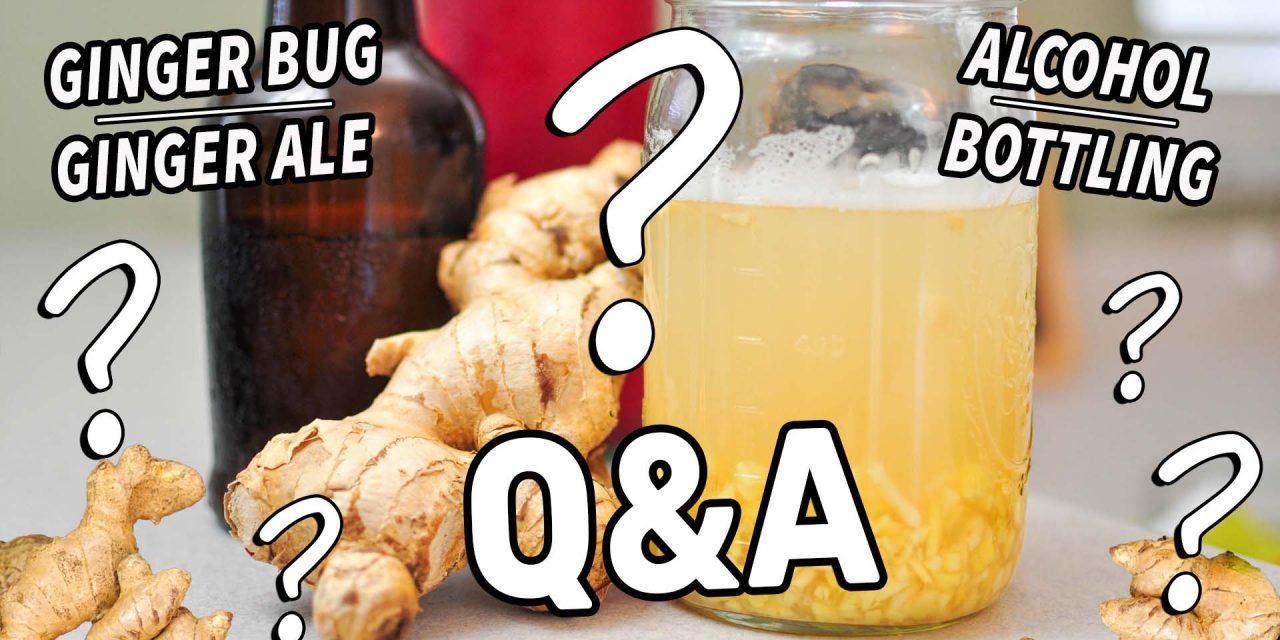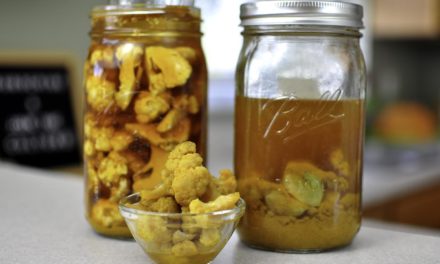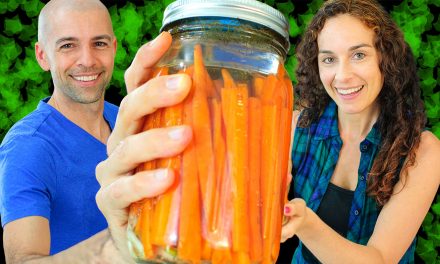Making fermented drinks is so addicting! They’re delicious, bubbly, and full of probiotics. Getting started is easy by simply making a ginger bug starter. It will lead you down the rabbit hole of so many tasty fermented drinks.
Drinks such as spicy ginger ale, fruit sodas like blueberry soda, blackberry soda, watermelon soda, and pretty much any tasty juice that you can imagine can be transformed in a matter of days. You can even make fermented drinks without a ginger bug such as the wildly popular Mexican pineapple tepache drink. Your options are literally endless!
But on this fermentation journey you’ve had questions. A lot of them! We’ve had questions come in from all over the world about ginger bug, ginger ale, and fermented drinks in general.
And that’s what we’re answering today in this video. Check it out and subscribe to our YouTube channel. We appreciate your support!
Ginger Bug Questions
Do you have to feed it regularly?
Typically it’s recommended to feed it once a week when it’s in the fridge, but we’ve gone a month without feeding it and it’s still alive and works well.
When you use your ginger bug, can you fill it back up with water?
Yes, you can add only non-chlorinated water at any time for more liquid volume in your ginger bug. The active ingredients will have more room to spread out and make the entire batch alive. But, you might as well freshen it up and feed it at the same time with 1 teaspoon of fresh ginger and 1 teaspoon of sugar.
Should my ginger bug be at room temperature before using it?
No, it’s not necessary to let it get to room temperature before using it. You can just take it directly out of the refrigerator, use it immediately in your ferments, and put it right back in the fridge. This is probably a good time to feed it as well while you have it out and it’s top of mind.
Will a ginger bug ever “go bad”?
It should be good indefinitely in the refrigerator if you feed it regularly, but could go bad if it gets contaminated.
How do I know if my ginger bug is still alive?
So, your ginger bug was bubbling and has since stopped. Is it still alive? Is it ready? This is perhaps the most common question! Mostly likely if it was once bubbling and has stopped, then it is ready. But you can do a quick test to see if it’s still alive. Just put about a teaspoon of your ginger bug in some sweet liquid (like fruit juice, milk, or even sugar water) and see if you start to get some bubbles. In our cashew milk test, we started to see bubbles within about six hours, whereas the milk without the ginger bug didn’t have any bubbles.
Can I remove the ginger pieces?
Yes, you can remove the old ginger pieces once they’ve done their job. You can even strain off all the ginger pieces and start fresh with just the liquid of your ginger bug. Although we’d recommend feeding it right before putting it back in the fridge.
Do I leave on the ginger skin?
It’s not necessary. It’s true that some of the bacteria we want in a ginger bug can be found on the ginger skin, but we’ve found that removing the skin doesn’t change how active our ginger bug is. This is good news! It means that the bacteria and yeast we want are present throughout fresh ginger! If the ginger we’re starting with comes from out of the country or is not organic, we usually remove the skin to get rid of some of the contaminants that might be present that would be concentrated on the outside. If you hear that you NEED to leave the skin on to make a ginger bug, it’s false. When we’ve removed the skin on our ginger when making a ginger bug, it has always worked for us. Keep the skin or remove it. It works either way!
Is a pink/brown ginger bug safe?
Depending on where you are in the world and the minerals that are in your water and soil, it’s common for a ginger bug to turn a bright pink. However, it should be clear and bright in nature. A brownish, slimy, or very cloudy ginger bug would be a concern and we’d recommend starting over.
How come I’m not seeing bubbles?
Your ginger bug may be slower to get started and may take longer to see bubbles than you saw on our video. We might be in a different climate than you, so you’ll probably have different conditions for your ginger bug. If you’re not seeing bubbles after a few days, it’s possible your ginger bug was contaminated, had traces of chlorine, or was sterilized by harsh direct sunlight. We’d recommend starting over on your ginger bug.
Can you create a starter culture for fermented drinks using fruit other than ginger?
Yes it’s possible but we’ve found that ginger is more reliable and a stable culture that you can use repeatedly to get a soda started quickly.
My ginger bug was bubbling but is no longer bubbling. What’s wrong?
It’s probably fine. It may have been active and only slowed down because it’s reaching the peak of the fermentation process. This means it might be ready to use! Try making a new soda with it.
Can you freeze ginger for later?
Yes, the freezing process should not kill the bacteria in and on the ginger. It should reactivate when you’re ready to use it for a ginger bug or ginger ale.
Can you use ground ginger?
No. Ground ginger is no longer alive, so it will not work for a ginger bug.
Does a lot of head space hurt the fermentation process for a ginger bug?
For a ginger bug, it should not be a problem. Many people simply place a towel over the jar meaning it’s an open-air ferment.
Is it fine if my ginger is floating?
Yes, this is alright. Generally, fresh ginger floats at first and then will start to sink as it gets water-logged.
In the refrigerator, what type of lid should I use for the ginger bug?
Definitely use a loose lid like a twist top that’s not fully screwed on because your ginger bug will continue to produce bubbles slowly while in the refrigerator. If you use a tight lid, that air will have nowhere to go, and will start to pressurize the ginger bug container, which you do not want unless you’re making it into a carbonated drink.
Tester Bottle Questions
Does the tester bottle have to be the same size as the other bottles?
No, it doesn’t have to be the same size, but try to fill it to the same ratio (liquid to air) as your other bottles. This way they will pressurize at the same rate, and your tester bottle will be a good indicator of the amount of pressure that is building in your other bottles.
Do you throw away the tester bottle after every use?
This is a common question and also a personal one. We are comfortable reusing the plastic tester bottle for the secondary fermentation on a few different batches of ferments of the same type. If you are using a plastic bottle for your tester bottle, you would not want to use the same bottle for multiple types of ferments like a ginger bug and then a kombucha, because these are different cultures and the plastic bottle would cause cross contamination. Since we are only using the tester bottle for 1-2 days per ferment, we are comfortable using it a few times before tossing it, but this is completely up to you and your comfort level with plastics.
What’s a good tester bottle?
We like to use plastic tester bottles so that you can test the pressure that is building by physically being able to squeeze the bottle. If you decide to use a plastic bottle, make sure it’s a recyclable, PET (#1) bottle that is specifically used for sodas and other acidic drinks. They’re built just for that purpose for a reason.
Do you have to use a tester bottle?
You should definitely have some way of testing the pressure in glass bottles if you’re carbonating drinks, or at least ensuring that you’re limited the maximum amount of pressure building up. If you don’t want to use plastic bottles, you could use only the glass bottles, but burp the bottles every 12-24 hours to see how much pressure is building. If it appears to be very active after the first 12 hours, go ahead and refrigerate right away. You could also just decide to carbonate for a very short time, about 12 hours, just to be safe. Another option is to skip the entire step of carbonation (secondary fermentation process). Your ferment is ready to drink after primary fermentation and can be placed directly in the refrigerator in either pressure-safe glass bottles or in a container with a fermentation lid (that allows excess air to escape).
Glass Bottles and Carbonation Questions
How do you sanitize your bottles?
This is an important step because it prevents contamination in your ferments. We wash the bottles with hot water and dish soap, then let them dry completely. We like to use a bottle drying rack that dries them upside down so they dry more quickly, and so that nothing enters the bottles while they’re drying.
Do the bottles have to be brown?
No, the bottles do not have to be brown for the bottling process. Brown bottles are good for ferments that you’ll be storing for longer periods like beer because it keeps more of the light out. Since it’s popular for beer, brown bottles are the most readily available pressure-safe bottles on the market and you’ll usually see that they have flip-tops so you can easily reuse them.
Do you have to burp the bottles daily during carbonation?
If you’re using a tester bottle, then you don’t need to open, or “burp”, your bottles during the carbonation process because that would defeat what you’re trying to do, which is keep the air in the bottles. If you’re not using a tester bottle or are worried about the pressure, then you will need to burp the bottles every 12-24 hours to make sure the pressure isn’t building too quickly. We also recommend burping the bottles once in a while after you put it in the refrigerator because it will continue to slowly ferment and create more carbonation.
Can you ferment directly in the glass bottles and skip the mason jar?
Technically, you could just do your primary fermentation straight in the bottles for some ferments, but it’s a good standard practice to ferment in one larger container before the bottling process in order to make sure that it works. There are a number of reasons for this. If your ferment goes bad and you have to start over, it’s much easier to clean out the one larger container than it would be to clean all the individual bottles. If your ferment gets a layer of kahm yeast or mold, it would be difficult to remove from the individual bottles. If you want to taste test and adjust your ferment along the way, like adding sugar or adding water, it’s much easier to do this in one large container versus the bottles. And last, but not least, for drinks that ferment with the fruit in it (like tepache), it’s not possible to ferment directly in the soda bottles because you’ll need to filter out the fruit first.
Ginger Ale Questions
Can I use ginger juice instead of boiling ginger to make ginger ale?
YES! We just made a video on making ginger ale using fresh ginger juice, and it worked out great! It’s more nutritious because it hasn’t been boiled, and it’s also keep the spicier flavor of the ginger. But please be careful when bottling ginger ale made from fresh ginger juice, because it is much more active of a ferment than its counterpart made from boiling the ginger soda syrup.
Can you make your ginger bug directly into ginger ale without saving it?
If you don’t want to store your ginger bug for future use on other fermented drinks, then yes, you can make a ginger bug and use the entire batch to make ginger ale.
What’s the shelf-life of ginger ale?
Once it’s bottled and refrigerated, the shelf life can be years. It doesn’t exactly go bad, but the flavor starts to change and the alcohol content will increase over time. If you like the flavor at the time you bottle it, we recommend drinking it within six months. After a couple of years, more sugars are eaten up and the ginger ale becomes very dry.
Can you consume too much ginger ale?
Homemade ginger ale has probiotics and is good for your digestive system, but consuming too much of it may not be good for you. Ginger ale is a soda and has sugar, so consuming a lot of it would mean a lot of sugar. Several online articles also speak to negative side effects of too much ginger itself if you overdo it. So, all things in moderation!
Is the boiling process necessary when making ginger ale?
It’s not necessary, but boiling a soda syrup sterilizes everything so that it gives you a controlled environment in which to add your ginger bug starter culture . Your ginger bug is more likely to work and take over in a controlled environment.
Does lemon juice serve a purpose other than flavor?
It’s mostly for flavor. You can make ferments without it, like tepache! The lemon juice may slow down activity of the ferment a little bit due to the pH of the acid, but it’s not guaranteed. As you saw with our ginger ale recipe made from fresh ginger, adding lime juice didn’t seem to slow down the ferment and it was still very active.
Can you use finished ginger ale as a starter culture for another batch of ginger ale?
Yes, a finished homemade ginger ale is basically like a starter culture that can be used for the next batch. The reason we have a ginger bug starter culture always in waiting is because we usually drink all of our ginger ale and don’t have any left to be used as a starter culture.
How can a half gallon recipe call for a half gallon of water, plus other ingredients? Won’t this exceed my half gallon jar?
The order matters when putting your ingredients into the jar matter. When you save adding water to the end, it makes it easier to top up the jar to the correct level so you don’t overflow the jar. Sometimes your jar might even have a large amount of fruit that you’re fermenting and you need to top of the target level at the end to the half gallon mark.
Is it OK to have sediment on the bottom?
Yes, it’s perfectly fine. In fact, that’s where you’ll find a lot of the flavor.
Can you use honey as a sweetener?
We like to use raw granular sugar over honey because honey has antimicrobial properties and may interfere with your ferment. You can try it but it might slow your ferment down or not ferment at all.
Does it matter when I add the sugar in making ginger ale?
You can add the sugar either before, during, or after the boiling process and it will not change your results.
Alcohol Questions
Is it alcoholic?
Yes, fermented drinks do have some alcohol since it’s a natural byproduct of the fermentation process.
How much alcohol is in my ginger ale?
Your alcohol content will vary depending on how much sugar is in your recipe, how active your ferment is, and how long you let your drink ferment. There’s a great video on the alcohol content of ginger beer that one YouTube channel did that’s worth a watch.
Generally for our recipe, we’re estimating the following alcohol content for ginger beer that we make:
1 ¼ c. sugar for ½ gallon recipe
After 24 hours – 0.2%
2 days – 1%
3 days – 1.5%
4 days – 1.6%
Much longer it could get up to 3-4%
Are fermented sodas OK for children?
This is a personal decision, but the less time you ferment your sodas, the less alcohol it will have so it’s your choice.
How can I increase the alcohol of my ginger beer and make my ginger beer more alcoholic?
You can add a stronger yeast to digest more of the sugar like a champagne yeast. Once the ginger bug has gone as far as it will go the champagne yeast can take over and do more of the activity of turning sugar into alcohol.
Your Questions Answered!
Maybe you’ve caught the “bug” like us and are now making fermented sodas of all kinds. We hope you’re enjoying your fermented drinks and that you’re learning a ton.
Leave us a comment below and don’t forget to subscribe to our YouTube channel!








What would you say is the least amount of sugar I can use? Sugar is not great for my husband….I would like to make some and then sweeten AFTER it ferments with organic stevia to taste. I know it’s probably a matter of trial and error, but wondered what is the least amount you all have used?
Hello Kathy, you have a couple of options you can do. You can either start with a very small amount of sugar which won’t ferment for very long. You could consider this fuel for the bacteria and yeast which will run out very quickly and not have a long fermentation. Otherwise if you use the original recipe or even a bit less sugar, you can ferment it all the way out where there’s no or very little sugar left. If you ferment it all the way out, the alcohol content will be higher and the flavor will be much stronger. You can always try both and see which way you like better! They’ll both taste very different. Good luck and happy fermenting! 😊
Hi Paul and Sarah. Thank you so much for the great tips you’ve shared. I came looking for answers as to whether my poor neglected bug was still alive. I saw that you said dried ginger won’t work and, wanted to say that, here in Aotearoa/ New Zealand fresh ginger was unobtainable until a decade or so ago and all our ginger beer bugs were made with dried ginger – because of the price of fresh ginger, mine still is. We use dried ginger, sugar and a few raisins to start. I imagine the taste is slightly different but, it’s certainly not unpleasant and (possibly because of the raisins) definitely still works. In case you’re curious, I’m sharing the bug recipe and method l got from my aunt and have happy childhood memories of the delicious ginger beer she was making 60 odd years ago. At family picnics, it usually lay in the river hemmed in by rocks or tied to a tree branch so it wouldn’t float away while we swam. Sadly a batch exploded in the linen cupboard and the work involved in washing the linen for an entire household meant she made no more.
GINGER BEER FROM DRIED GINGER
• STARTING A NEW BUG – 2 WEEKS
• Day 1. Place 3 raisins in a clean glass jar and add 2 teaspoons of sugar and 2 cups (600 mls / 21 fl oz.) of cold water. Keep a cloth lid on the jar secured with a rubber band and sit it on the bench.
• Day 2. Add 2 teaspoons of sugar and 2 teaspoons of ground ginger. Stir.
• Day 3. Add 2 teaspoons sugar. Stir.
• Day 4. Add 2 teaspoons of sugar and 2 teaspoons of ground ginger. Stir.
• Day 5. Add 2 teaspoons sugar. Stir.
• Day 6. Add 2 teaspoons of sugar and 2 teaspoons of ground ginger. Stir.
• Day 7. Add 2 teaspoons sugar. Stir.
• Day 8. Drain off the liquid from the jar and keep the sediment.
• Throw away the raisins and the liquid – as it’s not active enough yet.
• Place 3 new raisins and 2 cups (500 mls) of cold water in the jar.
• Day 9 – Day 14. Repeat Days 2 – 7
• Day 15. Bug is now active and can bottle first batch. Drain off the liquid Do not throw it away this time.
BREWING FROM AN EXISTING BUG
– 1 WEEK
• Day 1. After you’ve strained off your ginger liquid for bottling, remove half the sediment from your jar. If you don’t do this, it builds up and you have no room for your liquid. You can start another jar with this sediment or compost it.
• Add 2 teaspoons of sugar and 2 cups (600 mls / 21 fl oz.) of cold water to your glass jar and remaining sediment. No need to add more raisins now your bug is active.
Repeat Days 9 – 15 as often as you want.
Thank you so much for sharing Niki!! That’s a great overview of the troubleshooting you did. Super helpful! 😊